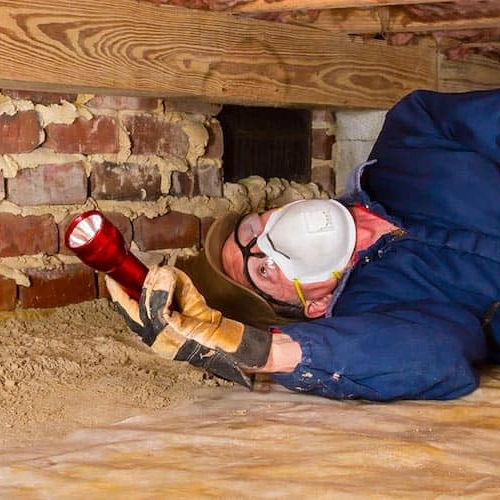A buyer's home inspection checklist
Contributed by Sarah Henseler
Dec 9, 2025
•7-minute read

Getting a home inspection before buying a house might seem like a small thing, but it’s one of the most important moves you can make as a buyer. It not only gives you a detailed account of the condition of the property, it alerts you to any potentially costly issues.
A home inspection gives you confidence and peace of mind in your purchase, and a chance to rethink or renegotiate the deal with the seller if the inspection reveals major flaws.
Before you order a home inspection, it’s important to fully understand the process and costs involved. It’s also important to have a comprehensive checklist of areas and systems to cover so you can avoid any costly missed issues.
So let’s dig into everything you’ll need to know for a successful home inspection.
What is a home inspection?
A home inspection is a noninvasive, visual review of a home’s structure and major systems. So, it doesn’t include such things as punching holes in walls to check electrical or plumbing. But it does mean that an inspector will check the safety, quality, and condition of all the home’s systems and its structure, from the electrical and plumbing to the foundation and roof.
The inspector will identify current and potential issues and provide you with a full report outlining them. You can then use this to assess your decision to buy the home. You can also use it to negotiate repairs with the seller, request credits from them, adjust the price, or even back out of the sale if major problems are uncovered.
You’ll typically get a home inspection after your offer has been accepted and you and the seller sign a purchase agreement, but before or at the same time an appraisal of the property.
Home inspection checklist for buyers
Your professional home inspector will have their own detailed list of areas they’ll check. But having your own checklist helps you follow along and ensures that every area is assessed. Here’s a checklist you can keep with you.
Grounds and exterior structure
- Foundation appears in good condition with no significant cracks
- No evidence of leaks from the septic tank
- Drainage away from the house with no standing water
- Easily accessible crawl spaces to get to plumbing
- Exterior walls appear straight, with no sagging
- Windows and door frames appear square
- Siding appears in good condition, with no cracks or damage
- Bricks appear undamaged, with no cracks in joints
- Paint isn’t flaking or stained
- Roof shingles aren’t missing or damaged
- Gutters show no decay and drain properly
- Chimneys appear straight and undamaged
- Detached garage, shed, fence, and deck appear in good condition, with no rotted wood or evidence of termites
Basement
- No evidence of moisture
- No evidence of water damage to floor
- Sump pump operates properly
Attic
- No evidence of staining from roof
- Structure shows no damage or decay
- Adequate ventilation through soffit vents and end louvers
- Insulation is sufficient and installed properly
- Contained electrical splices
Bathrooms
- Visible plumbing under sink is in good condition and shows no signs of water damage
- Adequate water pressure for hot and cold water at all fixtures
- Tub, shower, and sinks drain smoothly
- Toilet flushes and fills properly
- Toilet is stable with no rocking or stains at base
- No evidence of leaking around base of tub or shower
Kitchen
- Visible plumbing under sink is in good condition and shows no signs of water damage
- Working exhaust fan vents to outside
- Garbage disposal is operational
- Water flow to sink is adequate and drains properly
- Built-in appliances operate properly
Interior rooms
- Floors, walls, and ceilings appear straight and level without visible stains, cracking, or damage
- Doors open easily and latch properly when closed
- Lights and switches operate properly
- Adequate number of electrical outlets in each room
- Heating and air conditioning vents in all rooms
- Fireplace has no cracking or staining
- Cleaned and lined fireplace flue
- Smoke detectors and carbon monoxide detectors are working and property located
- Stairway treads and risers are solid
Electrical systems
- Wiring is in good condition
- Service panel has standard capacity, with cables attached correctly
- Secure and protected cables
- No exposed electrical splices
Heating and cooling systems
- No gas odor
- Air conditioning and heating operate well
- Air filters are clean
- Flues have no open seams and go up to chimney connection
- Cooling unit has no visible rust
Plumbing
- Visible pipes have no damage or evidence of leaks
- Water heater shows no signs of rust
- Water pressure is within accepted range
- Hot water temperature doesn’t exceed 125 degrees Fahrenheit
What fixes are mandatory after a home inspection?
The short answer is none. A seller is not legally required to make any repairs based on the buyer’s home inspection. However, you, as the buyer, can often make reasonable requests for repairs in order to satisfy financing requirements or address major safety issues.
And most states have disclosure laws. These laws require sellers to disclose known problems, such as structural issues, water damage, pest infestations, hazardous materials, and other known problems or defects. For instance, here’s the Texas disclosure law, Sec 5.008.
The more important point is that, while sellers aren’t required to make repairs, the home inspection gives you leverage to negotiate further. Home inspection contingencies are a common part of a purchase agreement, giving you the means to negotiate for repairs or seller credits before finalizing your purchase.
What is a home inspection contingency?
A home inspection contingency is a clause included in a real estate purchase agreement that states the sale is contingent on the results of the home inspection. This is an important clause that protects you, the buyer, from significant risk.
A home inspection contingency clause gives you the right to ask for repairs or seller credits, renegotiate the sale price, or walk away from the deal without penalty. So, bottom line: you want one in your contract.
Waiving a home inspection contingency means that you might be forced to go ahead with a sale despite major, costly or dangerous issues being discovered during the inspection. If not, you’d be in breach of contract, losing your earnest money and facing potential legal action by the seller.What happens after the home inspection?
Once the home inspector finishes their work, they’ll give you a detailed report on the condition of the property. This report lists the condition of virtually every aspect of the home and highlights issues both large and small. As such, it can be quite long.
However, don’t take the report’s length as a sign of trouble. It is merely a reflection of the thoroughness of the inspector’s work. They’ll typically also walk you through the report, pointing out any major concerns, and explaining what areas need immediate attention.
With this knowledge literally in hand, you can now make an informed decision of whether to go through with the deal or ask the seller for repairs or credits toward the cost of repairs.
FAQ about home inspections
A home inspection is one of the most important stages of the homebuying process, protecting you, the buyer, from unwittingly inheriting major issues. As such, it can generate a lot of questions. Here are answers to some common ones.
How much does a home inspection cost?
The average cost of a home inspection before buying is about $343, but it can vary between $296 and $424 depending on the home’s size, age, and location, according to 2025 data from Angi.
Who pays for the home inspection?
Typically, the buyer pays for the inspection. This is because the home inspection is primarily for the buyer’s benefit, protecting them from making an uninformed purchase and inheriting costly problems.
How long does a home inspection take?
Most home inspections take about 2 to 4 hours, depending on the property size. It usually takes up to 2 days afterward for the buyer to receive the inspection report.
What’s the difference between a home inspection and an appraisal?
A home appraisal determines a property’s market value based on local sales and overall condition, but doesn’t inspect the fine details of the home. By contrast, a home inspector evaluates the home’s physical condition.
How can you find a home inspector?
Ask your real estate agent to help you find a home inspector. Most agents have relationships with certified, insured home inspectors and can recommend one they trust.
What are the most common problems found in a home inspection?
Common things a home inspector finds include roofing issues, problems with the HVAC system, faulty electrical wiring, dry rot, mold, and structural damage.
What fixes are mandatory after a home inspection?
A seller is not legally required to make any repairs after a home inspection. But buyers can make reasonable requests for repairs to satisfy financing requirements. They can also use the home inspection to further negotiate with the seller or walk away from the deal.
The bottom line: A home inspection ensures your dream home isn’t a nightmare
Buying a home is an exciting – and major – financial decision. That’s why getting a home inspection is vital. While it does cost you money, it’s well worth the price. A home inspection can uncover minor and major issues with a home, preventing you from purchasing a house full of costly surprises.
As long as you have a home inspection contingency clause, a home inspection also gives you the right to negotiate with the seller for repairs or credits, renegotiate the price, or walk away from the deal without penalty. Bottom line: it protects you.
To get the most out of your home inspection, print the home inspection list in this article so you can ensure a thorough inspection. And when you’re ready to buy your home, Rocket Mortgage® is here to help. Apply for a loan today!

Terence Loose
Related resources

7-minute read
A guide to the home inspection contingency
A home inspection contingency allows buyers to respond to results within a specific time frame. Learn how to successfully navigate and reply to an inspection.
Read more

3-minute read
Appraisal vs. inspection: A guide
Appraisals and inspections are critical steps in the home buying process. Learn how to identify the key differences in appraisals versus inspections.
Read more

6-minute read
What is a 4-point inspection?
A 4-point inspection looks at a property's four major systems. Learn more about what a 4-point inspection is and why you may need one before purchasing a home.
Read more